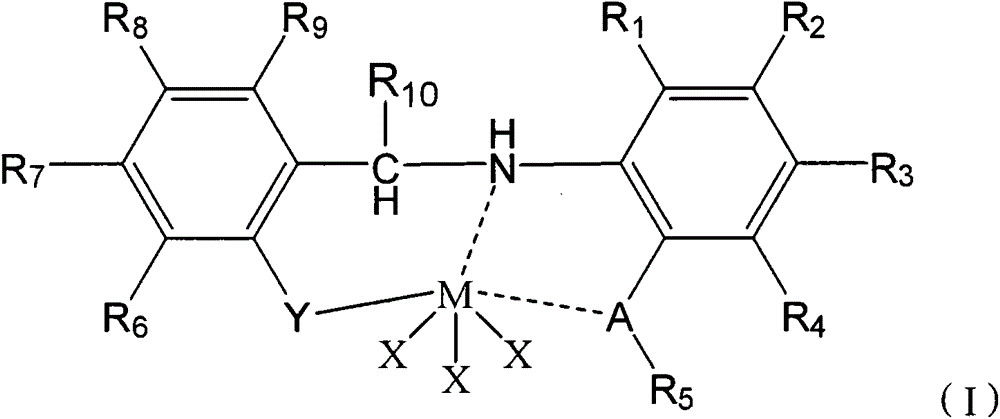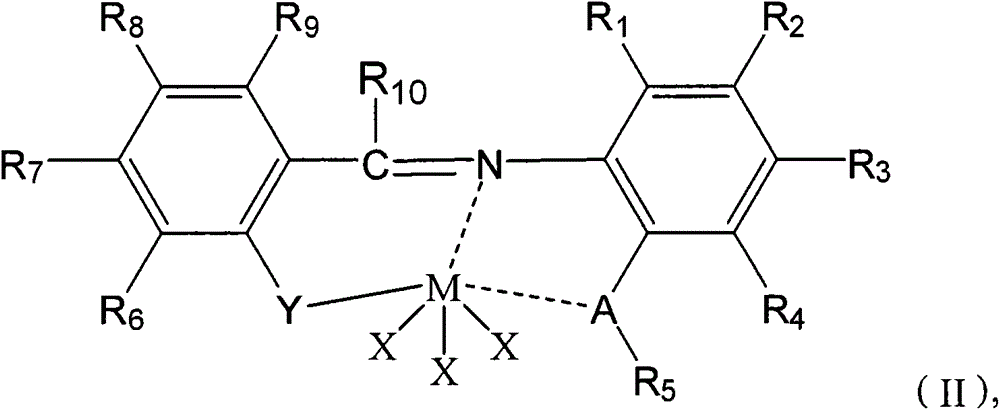Non-metallocene catalyst and manufacturing method and application thereof
A kind of non-metallocene and catalyst technology, applied in the field of non-metallocene catalyst contacting products
- Summary
- Abstract
- Description
- Claims
- Application Information
AI Technical Summary
Problems solved by technology
Method used
Image
Examples
Embodiment
[0245] The following examples will be used to illustrate the present invention in further detail, but the present invention is not limited to these examples.
[0246] Various performance parameters involved in the examples and comparative examples were measured according to the following methods.
[0247] (1) Polymerization activity
[0248] Catalyst polymerization activity (unit is g(P)·(mol(M)·h) -1 , wherein P refers to the copolymer, M refers to the metal element M such as Ti) is calculated according to the following formula.
[0249] Polymerization activity = m 1 ×4×Mw / m 2
[0250] in,
[0251] m 1 The amount (g) of copolymer obtained for 15 minutes of polymerization time;
[0252] Mw is the molecular weight of catalyst;
[0253] m 2 is the amount of catalyst added (g).
[0254] (2) Molecular weight Mη of copolymer
[0255] The viscosity-average molecular weight Mη of the copolymer is calculated according to the following method.
[0256] According to the stan...
manufacture Embodiment 1
[0262] In a dry 500ml three-necked flask, add 2-aminoanisole sulfide (0.2mol), absolute ethanol (160ml), 3,5-di-tert-butyl salicylaldehyde (0.2mol), acetic acid (0.3ml) successively , heated up to reflux temperature and reacted for 2hr, cooled to room temperature, filtered, washed three times with absolute ethanol, and dried in vacuum to obtain 49.7g of 2-aminoanisole sulfide 3,5-di-tert-butyl salicylaldehyde, called Ligand L1. Elemental analysis: C 74.57% (theoretical value 74.32%); H 8.35% (theoretical value 8.22%); N 4.07% (theoretical value 3.94%). 1 H NMR δ=13.4(OH), 8.6(CHN), 7.5-7.1(Ar-H), 3.25(SCH 3 ), 1.45 (C (CH 3 ) 3 ), 1.35 (C (CH 3 ) 3 )
[0263]
manufacture Embodiment 2
[0265] In a dry 500ml three-necked flask, add 2-aminoanisole sulfide (0.2mol), absolute ethanol (160ml), 3,5-di-tert-butyl salicylaldehyde (0.2mol), acetic acid (0.3ml) successively , heated to reflux temperature and reacted for 2 hours, cooled to room temperature, filtered, washed three times with absolute ethanol, and dried in vacuum to obtain 49.7 g of 2-aminoanisole sulfide 3,5-di-tert-butyl salicylaldehyde.
[0266] Slowly add a diethyl ether solution of lithium aluminum hydride (0.2 mol) to the toluene solution of 2-aminoanisole sulfide 3,5-di-tert-butyl salicylaldehyde (0.1 mol), and continue stirring for 30 minutes after the addition is complete. The reaction was terminated by adding ice water to the reaction solution. Purified by column chromatography to obtain a compound represented by the following formula, which is called ligand L2. Elemental analysis: C 73.67% (theoretical value 73.90%); H 8.71% (theoretical value 8.74%); N 4.08% (theoretical value 3.92%). 1 H N...
PUM
 Login to View More
Login to View More Abstract
Description
Claims
Application Information
 Login to View More
Login to View More - R&D
- Intellectual Property
- Life Sciences
- Materials
- Tech Scout
- Unparalleled Data Quality
- Higher Quality Content
- 60% Fewer Hallucinations
Browse by: Latest US Patents, China's latest patents, Technical Efficacy Thesaurus, Application Domain, Technology Topic, Popular Technical Reports.
© 2025 PatSnap. All rights reserved.Legal|Privacy policy|Modern Slavery Act Transparency Statement|Sitemap|About US| Contact US: help@patsnap.com



